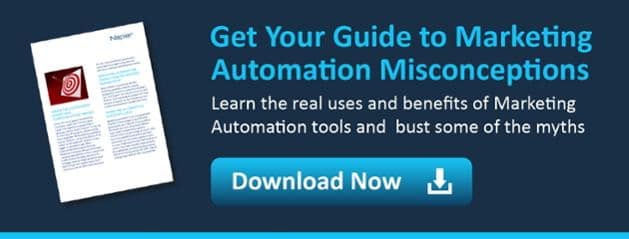Here’s the third chapter from our new Marketing Automation mistakes eBook. if you missed them, catch up with Chapter 1 and Chapter 2 now.
Many people wrongly believe that marketing automation makes communication sound robotic, this indicates that the people who believe this don’t fully understand what marketing automation does. On the contrary, marketing automation enables marketers to engage with their prospects, leads and customers better than ever with tailored content and progressive profiling. When using marketing automation, it is important not to overlook personalisation of content – adding someone’s first name at the top of an email is not enough. Personalisation is one of the subtle tactics that marketers can use to foster loyalty in their customers and win favour, helping them to stand out from the competition. With many companies having more complex buyer’s journeys and longer sales cycles, personalisation is beneficial for both the company and the customer. To maximise success, companies need to know their customers likes and dislikes. Each buyer’s journey is different because every buyer will have their own unique wants, needs and concerns, their own motivations and goals; which are constantly changing.
How does marketing automation help with personalisation?
Personalisation is needed on your website and marketing automation platforms can help here through the use of content optimisation systems to deliver the right content to visitors; content is generated based on different factors such as where their IP address is registered (geographically), whether they have visited the website before, or typically what their browsing behaviour reveals. Marketers can set rules in place to determine what content is served and when these rules are matched the visitor receives a unique display on the website that will be different to every other visitor. Overlooking optimising your website could result in potentially prolonging the buyers journey. For example, if you have a multilingual website, a good personalisation effort would start with serving your visitors the right language or the relevant page by tracking their IP address. This will shorten the buyers journey by not leaving them to find the information relevant to their geographical area such as currency (if you have an e-commerce site) or the closest distributors for your products. Personalisation grows more beneficial the longer you’ve been collecting data and is more influential when you have a better understanding of the prospects needs but it is important to be respectful with how much personalisation you use and how often.
Get personal – but not too early on
Let’s take re-targeting for example; it’s a form of programmatic marketing that uses cookie-based technology to follow visitors as they move to different websites. Cookies store information about the user’s behaviour, including which pages they viewed and how long they have stayed on that page for. When they leave to visit another website, the cookie triggers programmatic software, and the consumer is re-targeted with an ad relevant to the content they interacted with on your site. These ads will follow you from website to website so it’s important to use re-targeting respectfully. To achieve respectful retargeting is important to know all that you can about your buyer. A study on targeted marketing reported that “after consumers had visited a review site to seek out information about product details – and were closer to a purchase – then personalised ads became more effective than generic ads intended for a mass audience.”
Re-targeting tips
Re-targeting Ads should reflect the content that the visitor viewed, so don’t make the mistake of sending the same re-targeting ads to everyone who visits the site. A good example of effective use of re-targeting ads is from page abandonment. If a visitor has previously been on your site, and has tried to complete a landing page but abandoned it, you can attract them again with re-targeting. The next web site that individual enters can then be re-targeted with the offer and re-engage them. personalised content is a great tactic to employ further down the buyer’s journey and, using it closer to the decision stage in the buyer’s journey will be more effective.
If you’ve found these insights useful, download our marketing automation misconceptions tip sheet below:
Author
-
Emily joins the Napier Team as a digital marketing apprentice, with the support of Chichester College. Emily recently completed her A-levels in Fine Art, Photography and English Language.
View all posts

